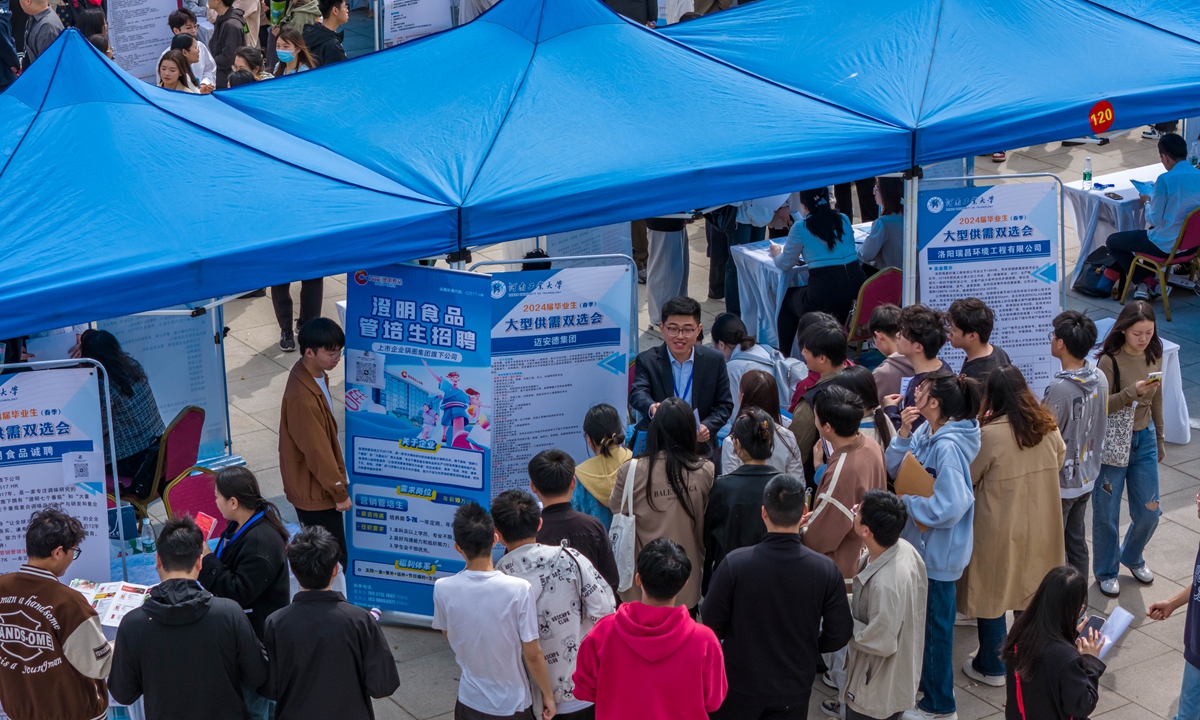
Students from a vocational training college in East China's Jiangsu Province practice smiling as part of their training to become bullet train attendants on May 7, 2024, one day before the World Smile Day. China created 3.03 million new jobs in the first quarter of 2024, signaling a good start for the country's employment market. Photo: cnsphoto
China's unemployment rate for youths aged between 16 and 24, excluding students, came in at 14.2 percent in May, down from 14.7 percent in April, the National Bureau of Statistics (NBS) revealed on Wednesday, which has been on a continuous downward trajectory since early 2024.The jobless rate of those aged 25 to 29 fell to 6.6 percent from 7.1 percent in April, continuing a down-trend that began in April. Experts said the trend indicated an accelerating improvement in China's job market.
The NBS on Friday released official data on the unemployment rates across different age groups in May, reflecting greater stability with declines in each group's figures.
Experts said that China's steady economic revival, backed up by the rapid development of new quality productive forces, and sustained policy support are pivotal advantages in stabilizing the labor market.
China's urban surveyed unemployment rate also maintained a declining trend, down to 5 percent from 5.2 percent in April, with data collected across 31 large Chinese cities decreasing by 0.6 percentage points year-on-year, according to NBS data released on Monday.
The decline in the unemployment rate is also a result of the government's sweeping policy agenda aimed at stabilizing urban employment, Li Changan, a professor from the Academy of China Open Economy Studies at the University of International Business and Economics, told the Global Times on Wednesday.
Li highlighted the ongoing economic recovery as a primary contributor to the declining unemployment rate and overall jobs growth.
Data released by the NBS on Monday showed that China's economy maintained stable growth in May, with key metrics for industry, export, and employment improving compared with April.
Li noted that better employment numbers hinge on steady economic growth. "The country is continuing to implement proactive fiscal and monetary policies to shore up economic growth, which is expected to support the stable growth in the job market in the second half of the year," he said.
But Li cautioned that although the unemployment rate has dropped, it remains elevated compared to a historical average, and structural issues may persist. There may be a slight rebound in the jobless rate in June and July when university graduates enter the workforce, he said.
A spokesperson from the NBS said on Monday that economic development solidifies the foundation for urban employment, noting the targeted development of the new quality productive forces in China will stimulate the development of new sectors and jobs too in the coming months.
According to data from the Ministry of Education, a record number of college graduates, totaling 11.79 million, are expected to enter the job market in 2024, 210,000 more than last year.
Meanwhile, driven by China's burgeoning high-tech development, the digital economy is projected to create jobs for a total of 449 million people by 2030, labor experts said.
China's economic rebound - especially in the manufacturing and services sectors - has driven up labor demand since the beginning of this year, while the development of new quality productive forces will help create a new growth point ensuing more job opportunities, Li noted.
Global Times



